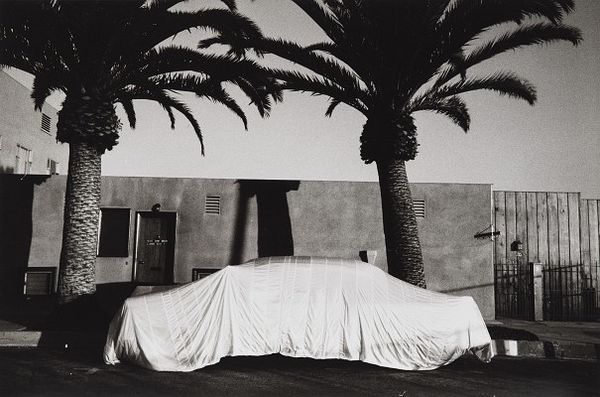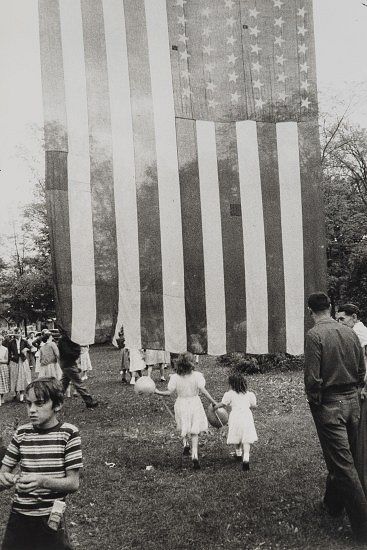Robert Frank, Parade – Hoboken, New Jersey, 1955. Estimate $80,000 - 120,000. Photographs New York.
-
A vast American flag draped across the facade of a building, obscuring the faces of the figures within.
-
A car parked alongside a lonesome stretch of Texas highway, the open road stretching into the distance.
-
The shimmering ghostly form of a covered car at twilight with palm tree silhouettes looming behind.
Each of these photographs contains a screenplay’s worth of narrative potential, and each packs its own undeniable visual punch. These indelible images by Robert Frank are among a choice selection by the photographer on offer in Phillips’ April 8 Photographs auction in New York that come from the collection of Robert Richardson and Monona Wali.
Robert Frank, U.S. 90, En Route to Del Rio, Texas, 1955. Estimate $100,000 - 150,000.
Photographs New York.
Mr. Richardson is a three-time Academy Award winning cinematographer who has worked with such acclaimed directors as Martin Scorsese, Quentin Tarantino, Oliver Stone, and Errol Morris. Few cinematographers have had as much impact upon the look of cinema in recent decades as Richardson, and his work can be seen in such movies as Once Upon a Time . . . in Hollywood, Platoon, and Casino, among many others. In 2019 he received the prestigious Lifetime Achievement Award from The American Society of Cinematographers. Ms. Wali is an award-winning writer, filmmaker, and teacher. They began collecting in the 1980s with acquisitions of work by Henri Cartier-Bresson, Robert Adams, Edward Weston, Tina Modotti, Danny Lyon, and many others – all images that synthesized the then-married couple’s dual interests in photography’s visual and narrative potency. At the heart of their collection is the work of Robert Frank.
Robert Frank’s work was my teacher in so many ways. He taught me with his precise vision how to look upon an America that others could not, or would not, or were unable to see. - Robert Richardson, ASC
Funded by a succession of modest Guggenheim Fellowships, Robert Frank traversed the country in the 1950s on a series of photographic expeditions that culminated in his seminal 1959 book, The Americans. What Frank saw on his travels was a country enjoying post-war prosperity but deeply riven by racial and class divisions. The book is united by a number of visual motifs which repeat throughout: the American flag, the automobile, and the open road among them. These motifs feature prominently in the photographs from Richardson’s and Wali’s collection.
Robert Frank, Covered Car – Long Beach, California, 1956. Estimate $50,000 - 70,000.
Photographs New York.
The present high status of The Americans in the pantheon of photographic literature, and in the pantheon of photographic achievement, was not anticipated by its reception when published in late 1959. Initial reviews were negative and the true scope of Frank’s project was unappreciated by many in the photographic establishment. Almost immediately, however, The Americans influenced younger photographers and the images they were making. Photographer Joel Meyerowitz observed, “It was the vision that emanated from the book that lead not only me, but my whole generation of photographers out into the American landscape.” Indeed, The Americans is a body of work whose impact is still being felt today.
Robert Frank, Fourth of July – Jay, New York, 1954. Estimate $60,000 - 80,000.
Photographs New York.
Robert Richardson counts Frank as a key influence on his own work in cinema: “Robert Frank’s work was my teacher in so many ways. He taught me with his precise vision how to look upon an America that others could not, or would not, or were unable to see. His career was not simply one book, The Americans, although many hold that up as perhaps the finest of his work, and the finest of anyone’s. But his later images and films with his family brought out the emotional heart of what he captured through his lens as he grew older and wiser. Many call him a documentary photographer. I see that perspective, but I also see vastly more. I see and feel the subjective point of view of a master – in my mind, the master.”
Robert Frank, View from Hotel Window – Butte, Montana, 1956. Estimate $70,000 - 90,000.
Photographs New York.
It is rare to see such a concentrated group of icons from The Americans appear at auction. Frank’s highly-personal graphic documentary style has lost none of its impact over the decades, and the pictures remain as relevant today as they were in the turbulent decade in which they were made.
Robert Frank, Political Rally – Chicago, 1956. Estimate $50,000 - 70,000.
Photographs New York.
Discover More from Photographs New York >
Recommended Reading
Abstracting the Photograph >
Elvis, Eggleston, and the Sounds of the City >






